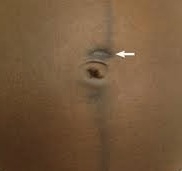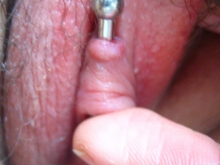Having a piercing problem? I can help!
This page covers: atrophic scarring, excessive scarring including keloids and hypertrophic scars, discoloration, and scar reduction products for healed piercings.
A scar is simply defined as “a mark left on the skin after the healing of a cut, burn, or other area of wounded tissue,” so scar formation is a normal process following any type of breach in the tissue, including piercing. Unfortunately, however, the body sometimes fails to perform this job properly and complications occur. Below are some of the most common scarring problems with suggestions on how to handle them.
Atrophic scarring, a depression or pitting below the normal skin level, sometimes occurs when a piercing migrates. Unfortunately, this type of scarring is usually permanent. Navel and facial piercings are the most common sites to find this type of pockmark. There are no easy fixes, but a dermatologist can explain treatments such as dermabrasion or laser resurfacing that might be effective. If the piercing can be maintained, generally the best way to deal with this problem is to leave jewelry in place. This will usually mask the scar or at least part of it.
Excessive Scarring
The presence of jewelry causes prolonged healing and predisposes the wound to chronic inflammation. Both of these conditions increase the likelihood of excessive scar formation. Keloids and hypertrophic scars are the types of bumps and lumps commonly found on ear cartilage piercings, though other pierced sites also fall victim to these conditions.
A keloid is a very large, dense mound of scar tissue that becomes significantly bigger than your original wound. They can be extremely unsightly, and some grow to shocking dimensions. Unfortunately, once you have formed a keloid, you can seldom fully recover from it and will always have some amount of scar tissue.
Identifying Keloids
• Bulbous and large, extending well beyond the boundaries of the original wound
• Sometimes tender, painful, or itchy
• Usually red or hyperpigmented and vascular, containing broad bundles of collagen, which are absent in hypertrophic scars
• Can develop over many months, or even up to a year following the piercing
What to Do for Keloids
Prevention is best: avoid piercings if you or a member of your immediate family has had keloids. Treatments are often ineffective and there is a high rate of recurrence, especially for those with a family history of keloid formation. There is a greater incidence of keloids in black and Asian populations, though anyone can get them. Combination approaches are common using multiple modalities as suggested by a doctor.
Disclaimer: These suggestions are not to be considered a substitute for advice from a medical professional.
Want to get pierced by Elayne Angel?
Hypertrophic Scars
A hypertrophic scar is a lumpy scar that sits above the surface of the skin. This is the smaller and far more common growth that forms around a piercing. They are not as big or severe as keloids, respond better to treatment, and are more easily resolved. Hypertrophic scarring sometimes goes away spontaneously, or it may recur and recede in cycles for an extended period of time before improving substantially or disappearing.
Hypertrophic scars are frequently mislabeled as keloids—even by doctors—possibly because both are types of excessive scarring. These problems tend to run in families and occur in about 5 to 15 percent of wounds.
Identifying Hypertrophic Scarring
• Raised fleshy bump surrounding a piercing that stays within the bounds of the injury
• Usually somewhat pink or red in color, at least initially
• Not tender; may itch
• Tends to form during the healing period
• No pus or other drainage
What to Do for Hypertrophic Scarring
Try one of the following methods at a time:
• HIGHLY SUGGESTED! If your piercing is on your helix (ear cartilage) or other area where a disc might sit flush against the scar tissue, check out the No-Pull Piercing Disc.
• NEW! Some piercees have had excellent results with bump/scar reduction using Briotech. It is certainly worth a try.
• A simple and inexpensive form of compression therapy (continuous mechanical pressure on a scar to flatten it) using Micropore breathable paper tape. It comes in “flesh tone,” which will not be visible on certain shades of skin. I personally found this to be effective in diminishing a hypertrophic scar that had formed on the back of one of my ear cartilage piercings. This is best used on healed piercings.
– Use scissors to cut a piece of paper tape that will fully cover the entire bump plus a millimeter or so of unaffected tissue. Use a clean hole punch to create a tiny dressing for the smallest of bumps.
– Cut a slit to the center of the bandage so you can place it around your ring or bar; you should be able to completely seal the piercing without covering the jewelry, as a Band-Aid would.
– Wear the tape continuously and change it when necessary. It can be left on during normal bathing.
– Discontinue if you do not see improvement in two to three months.
• Frequent mild saline soaks plus topical application of alcohol, 3 percent hydrogen peroxide, tea tree oil, or Campho-Phenique twice daily for two to three weeks. If you don’t see any improvement, try one of the other options. (The phenol in Campho-Phenique is a caustic substance that destroys tissue, so use it carefully.)
• Over-the-counter alpha hydroxy acid (AHA) cream used according to package instructions. This exfoliates skin and may diminish scar tissue over time. Use only over-the-counter strength (containing less than 10 percent AHAs). This concentration promotes exfoliation but is not potent enough to generate collagen production, which can increase the size of your hypertrophic scar. This product can cause sun sensitivity.
• Daily massage with a nonirritating oil or lotion to soften the tissue can be added to the following methods:
– Topical treatment with an over-the-counter corticosteroid cream according to the package instructions.
– Topical application of a chamomile tea bag compress for fifteen minutes, three times a day, for two weeks.
• Some piercees find laser or other medical treatments are effective. See a dermatologist for other treatment options.
Disclaimer: These suggestions are not to be considered a substitute for advice from a medical professional.
Discoloration
Some discoloration extending from your piercing in an area the size of a pea is a standard part of the healing process. It can remain for many months. Shades described as purplish, pinkish, reddish, or brownish are normal, depending on individual complexion. This discoloration is apt to diminish over time; still, a mark beyond the borders of your piercing could be permanent, depending on your skin type, healing course, and piercing placement.

Disclaimer: These suggestions are not to be considered a substitute for advice from a medical professional.
For healed piercings:
There are many scar-reduction products on the market. You may try to use them for any type of scarring, but they are less likely to be effective on atrophic or keloid scars. Unfortunately, even when you consistently comply with instructions, these treatments are effective for only some piercees. Certain products do have guarantees, however, so check before buying them. Listed below are some of the scar-reduction products available. Silicone strips may be the most economical treatment because they are washable and reusable.
• Scargo, Scar Freee, and other oils and lotions with natural ingredients such as cocoa butter, shea butter, aloe, arnica, calendula, or camphor (available at health food stores).
• ScarEase, ReJuveness, and other silicone sheets, and Biodermis, Kelo-cote, and other silicone gel systems. It isn’t understood exactly how silicone helps scars heal. Some researchers believe that static electricity from the silicone helps align collagen fibers in the scar, while others believe it might help to trap moisture, which can help scars to fade.
• Mederma, Derma E Scar Gel, and other products containing allicin (onion or garlic extract). This is intended to act as an anti-inflammatory and may inhibit the overproduction of collagen in a scar. These need to be rubbed in several times daily over an extended period of time.
What My Happy Clients Say
Elayne was wonderful and responded to all of my emails within 24 hours!! She provided great advice and showed detailed photos of what to look for.
I recommend ANYONE who has concerns with their piercings to contact Elayne and pay the consultation fee! It is worth it!!!! She is absolutely a godsend!
Best $ I have ever spent in my life! Elayne's response was friendly and detailed, reassuring and invaluable.
An expert, easy and convenient piercing consultation. This is the place to come for help.




